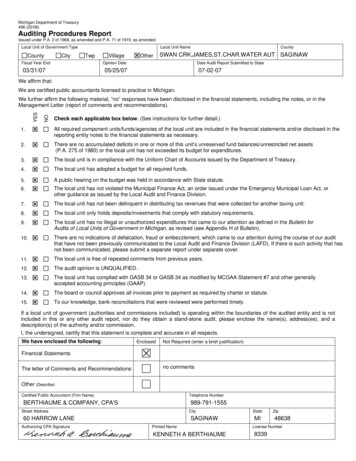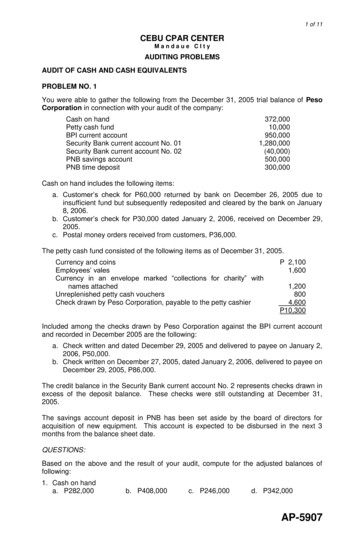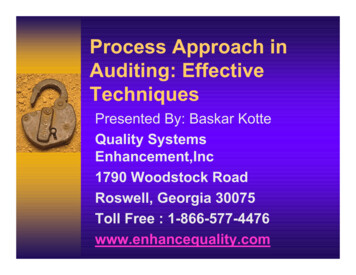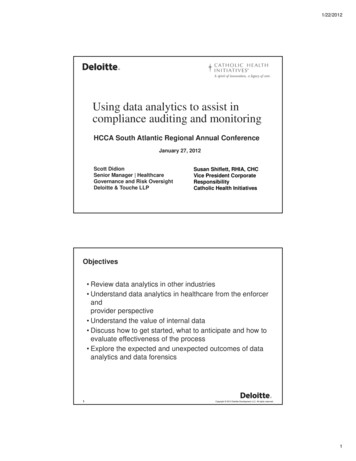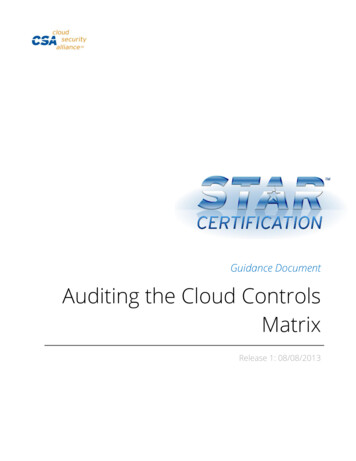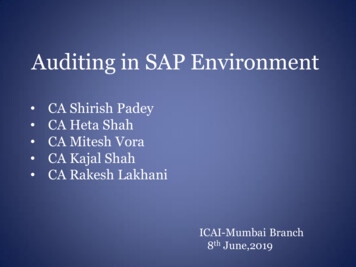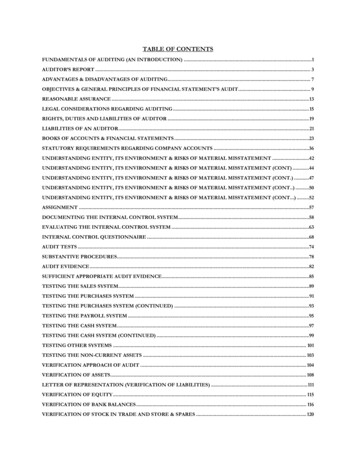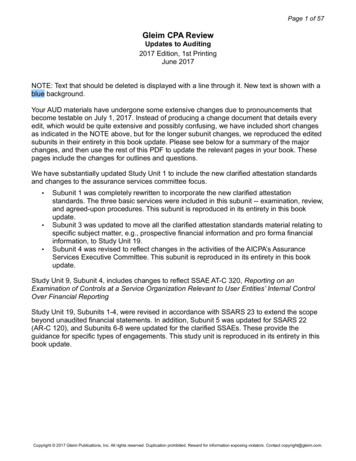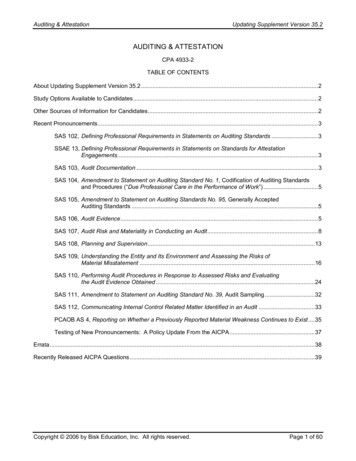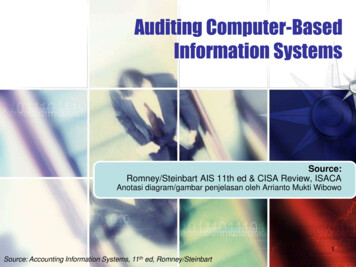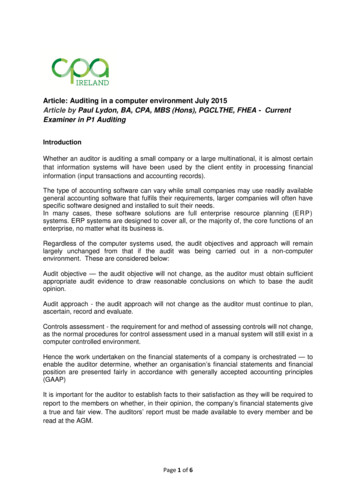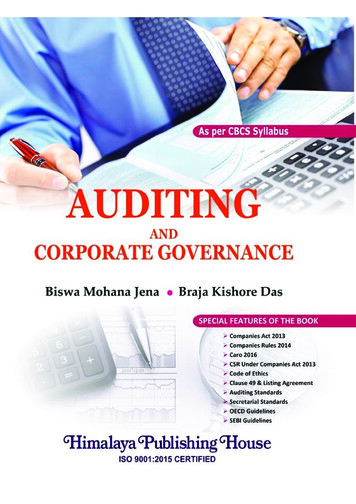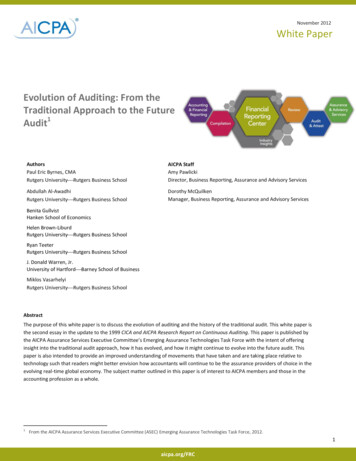
Transcription
November 2012White PaperEvolution of Auditing: From theTraditional Approach to the FutureAudit1AuthorsPaul Eric Byrnes, CMARutgers University Rutgers Business SchoolAICPA StaffAmy PawlickiDirector, Business Reporting, Assurance and Advisory ServicesAbdullah Al-AwadhiRutgers University Rutgers Business SchoolDorothy McQuilkenManager, Business Reporting, Assurance and Advisory ServicesBenita GullvistHanken School of EconomicsHelen Brown-LiburdRutgers University Rutgers Business SchoolRyan TeeterRutgers University Rutgers Business SchoolJ. Donald Warren, Jr.University of Hartford Barney School of BusinessMiklos VasarhelyiRutgers University Rutgers Business SchoolAbstractThe purpose of this white paper is to discuss the evolution of auditing and the history of the traditional audit. This white paper isthe second essay in the update to the 1999 CICA and AICPA Research Report on Continuous Auditing. This paper is published bythe AICPA Assurance Services Executive Committee’s Emerging Assurance Technologies Task Force with the intent of offeringinsight into the traditional audit approach, how it has evolved, and how it might continue to evolve into the future audit. Thispaper is also intended to provide an improved understanding of movements that have taken and are taking place relative totechnology such that readers might better envision how accountants will continue to be the assurance providers of choice in theevolving real-time global economy. The subject matter outlined in this paper is of interest to AICPA members and those in theaccounting profession as a whole.1From the AICPA Assurance Services Executive Committee (ASEC) Emerging Assurance Technologies Task Force, 2012.1aicpa.org/FRC
IntroductionAuditing is currently at a critical juncture. Specifically, advances in information technology in conjunction with real-timeapproaches to conducting business are challenging the auditing profession. As such, the primary purpose of this essay is toexamine the extent to which the auditing discipline in the United States has advanced and identify the trajectory it might take if itis to continue to thrive and provide long-run value to society at large.A Brief History of Auditing in the United StatesAlthough auditing procedures have been relied upon for many years, the formal practice of auditing has been in existence for arelatively short period. In addition, emphasis has historically been placed on a periodic, backward-looking approach whereby keyevents and activities are often identified long after their occurrence or simply undetected. Given that recent developments andtechnologies facilitated a movement away from the historical paradigm and toward a more proactive approach, it is essential thatauditors understand what the future audit entails and how they might begin to envision a logical progression to such a state. Toenhance this comprehension, it is advisable to consider how auditing has evolved from its formal beginnings in the early twentiethcentury.The Industrial Revolution and the resulting explosion in growth of business activity led to widespread adoption of auditingmethods. The railroads, in their efforts to report and control costs, production, and operating ratios, were major catalysts in thedevelopment of the accounting profession within the United States (Chandler 1977). Specifically, firms became aware of the needfor mechanisms of fraud detection and financial accountability, and investors increasingly relied upon financial reports ascorporations began to participate in the stock market. Although these issues prompted an expansion in the use of accounting andauditing mechanisms, it was after the stock market crash of 1929 that auditing became an obligatory process in the United States.In particular, the Securities and Exchange Act of 1934 created the Securities and Exchange Commission (SEC). Among otherresponsibilities, the SEC was initially given authority for the promulgation of accounting standards as well as auditor oversightfunctions. In addition, the SEC was required to enforce the mandate that publicly traded U.S. companies submit various periodicreports to the agency in a timely fashion. To assist the SEC with ensuring that these reports were created in accordance withgenerally accepted accounting principles (GAAP), public accounting firms were eventually required to provide certain assurancesabout the information.Many of the audit practices existing during the period that immediately followed were not conducted independently and,instead, simply relied upon information from management personnel. Furthermore, refinements of audit standards generallyconsisted of reactionary measures that occurred in response to significant negative business events. For example, audit tasks suchas physical inspection of inventories and confirmation of receivables were optional until fraudulent activities were uncovered atMcKesson & Robbins in 1939. As a result, the AICPA issued Statement on Auditing Procedure (SAP) No. 1 in October 1939 and itrequired that auditors inspect inventories and confirm receivables. Consequently, auditors became responsible for auditing thebusiness entity itself rather than simply relying upon management verification routines.Following this, auditing by inspection and observation became the norm. Even as automated accounting systems began toappear in the 1950s, manual auditing procedures continued to be used exclusively. For example, in 1954, UNIVAC was unveiled asone of the first operational electronic accounting systems in the United States. However, auditors only began to seriously considerauditing in the computerized context in the early 1960s; two specific events prompted this transition.First, in 1961 Felix Kaufman wrote Electronic Data Processing and Auditing. The book compares auditing around and throughthe computer. Historically, auditing around the computer entails traditional manual procedures in which the existence ofautomated equipment is ignored. As such, the computer is treated as a black box. In this context, auditors rely upon physicalinputs to and outputs from automated devices and do not concern themselves with how processing actually occurs within thesystem(s). Conversely, auditing through the computer involves actual use of computer systems in testing both controls andtransactions. Finally, auditing with the computer entails direct evaluation of computer software, hardware, and processes.Consequently, auditing through the computer or with the computer is able to provide a much higher level of assurance whencontrasted with auditing around the computer.Second, International Business Machines (IBM) released its IBM 360 in 1963 and this device made computing more affordablethan ever. Clearly, these developments collectively signaled a paradigm shift in terms of how accounting activities were to beconducted in the future and facilitated serious consideration of movement away from the traditional manual audit.Notwithstanding the progression toward computerized accounting, many auditors continued to audit around the computerand the minority who elected to audit through the computer relied on an array of proprietary programs that were expensive,cumbersome, inefficient, and in need of constant reprogramming. For example, Cangemi and Singleton (2003) mention that in2aicpa.org/FRC
1967, one firm developed between 150 and 250 unique auditing programs. Furthermore, nearly 80 percent of these programsrequired significant code modification in the subsequent year because of computer system enhancements and changes in auditrequirements. The introduction of AUDITAPE by Haskins & Sells in 1967, a card oriented auditor-friendly computer assisted audittool (CAAT), encouraged additional auditors to consider moving into the automated domain. In particular, AUDITAPE allowednontechnical auditors the increased ability to audit through the computer and facilitated the creation of several general auditingsoftware (GAS) programs from 1968 through the late 1970s. In conjunction with the development of these initial audit programs,Davis (1968) alerted auditors to the idea that they would simply not be able to ignore electronic data processing (EDP) inaccounting systems when performing audits. In addition, he explained how and when auditing around the computer might beaccomplished, but advised that an evaluation of internal controls as both a review and test of system reliability (audit of thecomputer) would still need to be performed. Davis had a significant and positive effect on the evolution of audit theory andpractice. Moving forward, the 1970s saw 2 major developments that dramatically altered the accounting and auditing landscapes.First, the Equity Funding Corporation scandal of 1973 is sometimes perceived as the single most significant event in EDP audithistory. In particular, the organization committed acts of fraud between 1964 and 1973 (Seidler et al. 1977). Essentially, managerscreated false insurance policies and commission income to artificially inflate profits and stock price and used a variety ofmechanisms to conceal the activities. For example, when auditors attempted to confirm receivables via phone calls to customers,switchboard operators at Equity Funding would simply connect the calls to employees who would subsequently confirm thebalance information. When the fraud was eventually unearthed in 1973, Equity Funding had 2 billion in phony insurance policiesand this reflected roughly 67 percent of the total balance in that general ledger account. In reflection, it was determined that anEDP audit would uncover the fraud much sooner. This determination was made primarily because all of the false policies wereposted to department number 99, whereas legitimate policies were not applied there.Whatever the case, the Equity Funding debacle was instrumental in mandating a shift from auditing around the computer.Furthermore, the incident prompted the review of existing audit processes in an effort to address internal controls and auditprocedures for information systems. As a consequence, large accounting firms, previously known as the Big 8, established unitsconsisting of EDP specialists to audit information systems. Smaller accounting firms often maintained contracts with informationsystems professionals to assist in auditing such systems.Second, the Foreign Corrupt Practices Act (FCPA) of 1977 had substantial implications for accountants. Basically, the FCPAprohibited American companies from bribing foreign officials to obtain business and required these firms to have mechanisms inplace to detect such activities. In addition, the FCPA required companies registered with the SEC to maintain their books andrecords such that transactions were accurately and fairly reported and consistently employ adequate systems of internal controls.Consequently, U.S. companies were forced to implement significantly more robust accounting systems as well as internal controlswithin those systems.During the next 25 years, many of the noteworthy events involving auditing of information systems pertained to thedevelopment and refinement of automated vendor offerings designed to increase effectiveness and efficiency in auditing. Theadvancement and proliferation of technologies such as the personal computer led to electronic data processing becoming morewidespread within organizations (Davis 1968). As an example, the author shows that the number of computers installed in U.S.based companies increased fourfold between 1962 and 1967. Along with this extensive distribution of computing power andsecurity risk came the increasing demand and need for micro-based computer assisted audit tools (CAATS) designed to aid inautomating the audit process. In fact, the flexibility and power of CAATS helped to bring improved audit quality and speed whendealing with the increase in data availability associated with automated systems.In response to the expanding demand for CAATS, vendor-based solutions began to appear in the marketplace and the needfor accounting firms to continue developing proprietary in-house audit tools was greatly diminished. For example, standardizedaudit tools such as Audit Command Language (ACL) and Interactive Data Extraction and Analysis (IDEA) emerged and offeredsignificant advantages over the COBOL-based programs of the previous period. Moving forward, such tools are periodically refinedand continue to provide valuable assistance to those seeking to audit through the computer today. Although CAATS have beeninstrumental in encouraging a shift away from traditional manual auditing, another fairly recent development has also had asignificant effect.Specifically, passage of the Sarbanes-Oxley Act (SOX) in 2002 imposed sweeping changes on publicly traded companies andthe accounting profession. SOX established that assurances about internal control practices and operations as well as financialreporting quality were the responsibility of both management and auditors. Furthermore, SOX caused the accounting discipline todevote more attention to addressing fraud during the course of an audit. For example, Statement on Auditing Standards No. 99,Consideration of Fraud in a Financial Statement Audit (AICPA, Professional Standards, AU sec. 316), requires auditors to design3aicpa.org/FRC
audit procedures that provide reasonable assurance of detecting fraud that could have a material effect on the financialstatements.As is evident from the preceding discussion, auditing maintains a very interesting past and refinements have occurredprogressively along the way that ultimately established capabilities for an improved audit experience. However, barriers continueto exist in evolving toward the future audit. For example, the traditional auditing paradigm whereby transactions are sampledbased upon risk considerations continues to be prevalent in the auditing profession today. Unfortunately, this process often failsto maximize util
Conversely, auditing through the computer involves actual use of computer systems in testing both controls and transactions. Finally, auditing with the computer entails direct evaluation of computer software, hardware, and processes.
